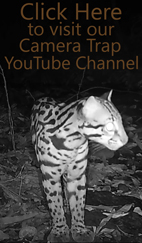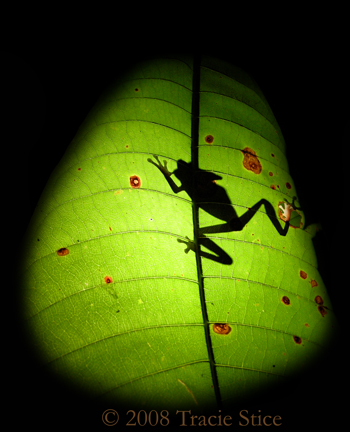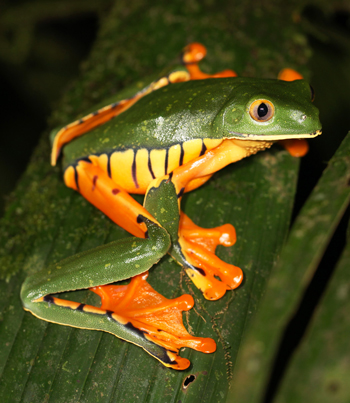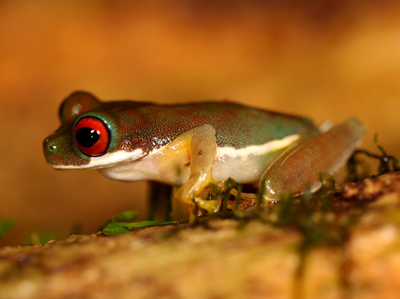|
Discover
the hidden treasures of Drake Bay, Costa Rica with Tracie
"The Bug Lady"

Home

Tour
Basics

Meet
the Bug Lady

Tales
from the Edge

Media

Reservations

Links



Facts about Drake Bay, Costa Rica

Travel To
Drake Bay

Drake Bay
Area Map

Hotel
Information

Tips for Travelers

Tours

Recommended
Reading




|
|
|

|
|
One excellent reason to visit
Costa Rica during the rainy months is to enjoy
our rich variety of frog species. Many are
graced with strikingly colorful patterns, others
are cryptic and blend into their surroundings
perfectly.
They
range in size from incredibly delicate glass
frogs to huge voracious Smoky Jungle Frogs,
capable of turning the tables on unsuspecting
snakes up to a foot and a half in length.
There is certainly great
variety among Costa Rica's frog species, but,
almost invariably, frogs have a permanent
smile and large, engaging eyes. At a glance
they seem quite friendly and curious, almost
comical, as they inspect you inspecting them.
As a photographer, I love photographing frogs.
They are charming and simply make wonderful
subjects.
Perhaps legendary turtle
conservationist Archie Carr says it best in
his book The Windward Road: "I have
always liked frogs. I liked them before I ever
took up zoology as a profession; and nothing I
have had to learn about them since has marred
the attachment. I like the looks of frogs, and
their outlook, and especially the way they get
together in wet places and sing about sex."
There certainly is something entirely
endearing about frogs. The following web pages
pay tribute to some of these amazing little
creatures who make so many of our Night Tours
so special, at times unforgettable.
|
|
 Frogs are the most
diverse and successful group of amphibians.
There are approximately 4400 identified species
worldwide and they inhabit every continent
except Antarctica. Frogs have managed to adapt
to even the most inhospitable climates. Some
frogs live in the desert and burrow into the
earth entering a type of hibernation for
most of the year. When the rains come, they
emerge from their slumber to breed in the
temporary pools formed by the rainstorms. Frogs are the most
diverse and successful group of amphibians.
There are approximately 4400 identified species
worldwide and they inhabit every continent
except Antarctica. Frogs have managed to adapt
to even the most inhospitable climates. Some
frogs live in the desert and burrow into the
earth entering a type of hibernation for
most of the year. When the rains come, they
emerge from their slumber to breed in the
temporary pools formed by the rainstorms.
At
the other extreme, there is a frog which
ranges into Alaska that freezes during the
winter, only to thaw out in spring to
reproduce once conditions are favorable. You
could literally put this frog in your freezer
for months, then take him out, let him thaw
and watch him hop away!! Talk about
resilience!
|
|
Frog diversity is at it's grandest in the
Tropics and reaches its zenith in the
rainforest.
There
are approximately 130 frog species in Costa
Rica and they inhabit almost every conceivable
habitat. From lowland marshes to mountain
treetops. Despite their relative abundance
throughout the country, seeing these
magnificent creatures in the wild requires
some effort and, as with every nature
encounter, a bit of luck.
Many of our guests comment that before The
Night Tour they had not seen any frogs on
their Costa Rican travels. Most frogs are
nocturnal and their activity peaks on rainy or
very humid nights. Even frogs that are active
during the day, like Poison-dart Frogs, are
elusive and shy. The frogs' call, which is
unique to each species, is usually a good way
to locate and identify them.
|
|
By far, the most amazing thing about frogs is
their lifestyle. You probably learned that frogs
lay their eggs in a river or pond.
A
tadpole then hatches out and develops in this
aquatic environment until it turns into a
frog. This pattern is shattered in the
tropics.
Scientists have documented about thirty-five
variations in the reproductive patterns of
frogs and toads worldwide, fifteen of which
occur in Costa Rica. Some of these patterns
test the boundaries of the imagination and
border on the bizarre.
As Adrian Forsyth and Ken Miyata write in
their wonderful publication Tropical
Nature: "Some Neotropical frogs will
stretch your credulity beyond its limit,
resembling as they do the creations of an
alien biology."
|
|
The
Marsupial Tree Frog (Gastrotheca cornuta)
is one such variation that defies belief.
These remarkable frogs, which are found on the
Caribbean Slope of Costa Rica, lead their
lives in the highest reaches of the forest
canopy. When they mate, the female will catch
her fertilized eggs with her feet as she lays
them and slip the eggs into a pouch on her
back! The embryos will go through direct
development in this pouch, bypassing a free
swimming tadpole stage, and the little
froglets will emerge from the pouch fully
formed.
 Other tropical
frogs will go through direct development
inside the egg, in some species with a parent
guarding the egg clutch. Once their
metamorphosis is completed tiny, fully formed,
froglets emerge from the eggs. Two of these
frogs, the Common Rain Frog (Craugastor fitzingeri)
and the Common Tink Frog (Diasporus diastema),
are featured on this website. Other tropical
frogs will go through direct development
inside the egg, in some species with a parent
guarding the egg clutch. Once their
metamorphosis is completed tiny, fully formed,
froglets emerge from the eggs. Two of these
frogs, the Common Rain Frog (Craugastor fitzingeri)
and the Common Tink Frog (Diasporus diastema),
are featured on this website.
One incredible variation is Eleutherodactylus
jasperi, from Puerto Rico. In this case,
fertilization was internal and the female kept
the eggs inside her oviduct. When the little
frogs hatched she would give live birth. I use
the past tense because this frog hasn't been
seen since the 1980's and is currently
believed to be extinct.
|
|
Amazing parental care is part of the
reproductive cycle of some Glass Frogs in the
Hyalinobatrachium genus, especially the
Reticulated Glass Frog (Hyalinobatrachium valerioi).
In this case, the male parent will guard
his egg clutches 24 hours per day. The male
Cricket Glass Frog (Hyalinobatrachium
colymbiphyllum) guards his eggs
through the night but abandons them during the
day. But, perhaps the parents most dedicated
to their offspring are some members of the
Poison-dart frog family, particularly the
Strawberry Poison-dart Frog (Oophaga
pumilio) and the Granular Poison-dart
Frog (Oophaga granuliferus).
 With
these tiny frogs egg laying generally takes
place on the ground, where three to five eggs
are laid. The father will then guard the egg
clutch, hydrating it occasionally to avoid
desiccation. After
the eggs hatch, the female returns to the
site and carries the tadpoles to water,
normally in the tank of a bromeliad. She
places each individual tadpole in its own
tank to avoid competition among siblings.
What follows is an example of parental care
unrivaled amongst the world's amphibians.
The mother will actually return to each
tadpole's tank periodically and feed them
unfertilized eggs!! Motherly love at its
finest. The generic name for this species,
Oophagus,
literally means "egg eaters". With
these tiny frogs egg laying generally takes
place on the ground, where three to five eggs
are laid. The father will then guard the egg
clutch, hydrating it occasionally to avoid
desiccation. After
the eggs hatch, the female returns to the
site and carries the tadpoles to water,
normally in the tank of a bromeliad. She
places each individual tadpole in its own
tank to avoid competition among siblings.
What follows is an example of parental care
unrivaled amongst the world's amphibians.
The mother will actually return to each
tadpole's tank periodically and feed them
unfertilized eggs!! Motherly love at its
finest. The generic name for this species,
Oophagus,
literally means "egg eaters".
|
|
But
perhaps the most incredible reproductive pattern
of any frog species is that of Australia's
endemic Gastric Brooding Frogs. The Gastric
Brooding Frog (Rheobatracus silus) and
the Northern Gastric Brooding Frog (Rheobatracus
vitellinus) were only discovered in 1972
and 1984 respectively. It remains unknown
whether the female swallowed her fertilized eggs
after mating or her tadpoles after hatching, but
all the tadpole's development took place inside
the mother's stomach! Their development took
about eight weeks and the mother could shut off
her stomach acids and did not feed for the
duration. 
She
could hold up to thirty young in her stomach
at one time. The stomach, swollen with
tadpoles, would get so large it would take up
most of her body cavity and her lungs would be
unable to fully inflate! When the froglets
completed their metamorphosis, the mother
would open her mouth wide and they would
emerge through her mouth! Sadly, these frogs
went the way of so many other species and are
now believed to be extinct. The Gastric
Brooding Frog was last seen in September 1981
and the Northern Gastric Brooding Frog was
last seen in March 1985, only one year after
it was discovered by scientists.
|
|
Worldwide amphibians are in crisis and
extinction seems to be a troubling trend. It
is estimated that about 25 percent of the
world's frog species are currently endangered.
Theories about the causes are as abundant as
they are varied. Pollution, global warming,
acid rain, the depletion of the ozone layer,
destruction of habitat, and the introduction
of invasive species have all been suggested
and all probably contribute to the decline of
amphibian populations.
 Currently,
scientists seem to agree that one of the mayor
problems facing amphibian populations is a
Chytrid Fungus discovered in 1999 called Batrachochytrium
dendrobatidis. This fungus is believed
to have spread from South Africa throughout
the world via the commercial trade of the
African Clawed Frog (Xenopus) which
began in the 1930's. The fungus causes a
disease called chytridiomycosis which is often
fatal. Currently,
scientists seem to agree that one of the mayor
problems facing amphibian populations is a
Chytrid Fungus discovered in 1999 called Batrachochytrium
dendrobatidis. This fungus is believed
to have spread from South Africa throughout
the world via the commercial trade of the
African Clawed Frog (Xenopus) which
began in the 1930's. The fungus causes a
disease called chytridiomycosis which is often
fatal.
It thrives in cool, humid environments and can
be expected to affect fifty percent of an
infected area's amphibian species, wiping out
eighty percent of the population of each
affected species. Its rate of
progression in Central America has been
calculated at 28 to 100 kilometers per year
and has been devastating.
|
|
During the late eighties, Costa
Rica's Monteverde Cloud Forest lost 20 out of 50
frog and toad species, including the beautiful
and endemic Golden Toad (Bufo periglenes).
Other Cloud Forests throughout the
country, including Braulio Carrillo National
Park, have also been affected. The endemic Hyla
xanthosticta is believed to have been
lost to this invasive fungus in Braulio Carrillo
National Park, along with most of the other
frogs there. 
Only
one specimen of this once rare species was
ever collected on the southern slope of Volcan
Barva. Australia's Gastric Brooding Frogs are
believed to have fallen victim to this
predator and countless others are in danger of
suffering the same fate.
The
sharp decline in amphibian population should
serve as our miner's canary and should not be
taken lightly. As conditions on earth
deteriorate due to pollution, depleting
resources, deforestation and an ever
increasing human population, it is these
sensitive species that will be the first to
disappear. By doing so, they are crying out a
warning to all of humanity. They are begging
us to respect all other species and allow
their coexistence - to take care of our
planet, which is our only home. They remind us
that humans are not immune to extinction and
that extinction is forever.
|
|
References:
Beletsky, L.
2005 Travellers' Wildlife Guides Costa
Rica Interlink Publishing
Brem, F. Lips,
K. Mendelson J.
Field-Sampling Protocol for Batrachochytrium
dendrobatidis from living amphibians,
using alcohol preserved swabs.
Available
from
http://www.amphibianark.org/chytrid.htm
Carr, A. 1955,
1979 The Windward Road The Florida
State University Press
Forsyth, A. 1990 Portraits of the
Rainforest Camden House Publishing
Forsyth, A. & Miyata
K. Tropical Nature Touchstone /
Simon & Schuster
Janzen, D. 1983
Costa Rican Natural History University
of Chicago Press
Leenders, T.
2001 A Guide to Amphibians and Reptiles
of Costa Rica Zona Tropical
Savage, J. 2002 The Amphibians and
Reptiles of Costa Rica University
of Chicago Press
Weldon
C, du Preez LH, Hyatt AD, Muller R, Speare R.
Origin of the amphibian chytrid fungus. Emerg
Infect Dis [serial on the Internet]. 2004 Dec
[date cited]. Available from
http://www.cdc.gov/ncidod/EID/vol10no12/03-0804.htm
|
Click
below for more information about Gian's book

|
|
|
|
The Frog Files





     







|



 Alien
Earthlings
Alien
Earthlings  The Dark Side
The Dark Side





 Frogs are the most
diverse and successful group of amphibians.
There are approximately 4400 identified species
worldwide and they inhabit every continent
except Antarctica. Frogs have managed to adapt
to even the most inhospitable climates.
Frogs are the most
diverse and successful group of amphibians.
There are approximately 4400 identified species
worldwide and they inhabit every continent
except Antarctica. Frogs have managed to adapt
to even the most inhospitable climates. 

 Other tropical
frogs will go through direct development
inside the egg, in some species with a parent
guarding the egg clutch. Once their
metamorphosis is completed tiny, fully formed,
froglets emerge from the eggs. Two of these
frogs, the Common Rain Frog (
Other tropical
frogs will go through direct development
inside the egg, in some species with a parent
guarding the egg clutch. Once their
metamorphosis is completed tiny, fully formed,
froglets emerge from the eggs. Two of these
frogs, the Common Rain Frog (

 Currently,
scientists seem to agree that one of the mayor
problems facing amphibian populations is a
Chytrid Fungus discovered in 1999 called Batrachochytrium
dendrobatidis. This fungus is believed
to have spread from South Africa throughout
the world via the commercial trade of the
African Clawed Frog (Xenopus) which
began in the 1930's. The fungus causes a
disease called chytridiomycosis which is often
fatal.
Currently,
scientists seem to agree that one of the mayor
problems facing amphibian populations is a
Chytrid Fungus discovered in 1999 called Batrachochytrium
dendrobatidis. This fungus is believed
to have spread from South Africa throughout
the world via the commercial trade of the
African Clawed Frog (Xenopus) which
began in the 1930's. The fungus causes a
disease called chytridiomycosis which is often
fatal. 







